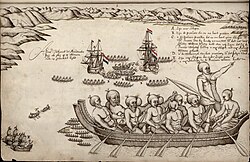Waka at Golden Bay, 1992 (30641865016)
Abel Tasman was one of several European explorers in search of a legendary “great southern land”, and in December 1642 he became the first European to officially view Aotearoa. Tasman had first sighted the coast on 13 December. His flagship, the yacht Heemskerck, and an armed transport ship, the Zeehaen, sailed up the West Coast, reaching Cape Farewell on the 16th. On the 18th they anchored in Wharawharangi Bay, off the Tata Islands to the north of what is now Abel Tasman National Park.
The local inhabitants were Māori of Ngāti Tūmatakōkiri, although other iwi may have been visiting or raiding the area. Two waka paddled out to inspect the ships more closely. The Māori challenged the intruders with ritual incantations and pūkāea or pūtātara (trumpet) blasts; in response the Dutch, shouted and blew their own trumpets. They then decided to fire a cannon, which according to an account from the Dutch ship’s barber-surgeon provoked an angry reaction.
On 19 December a number of waka came out to the Dutch ships. The Heemskerck’s small boat was sent to the Zeehaen to warn the crew to be on their guard and not to let too many on board. While returning to the Heemskerck, the boat was rammed by a waka and the sailors were attacked with paddles and ‘long staffs’. Three were killed and one mortally wounded. One of the dead was taken by the attackers, and the waka sped back to shore out of range of the muskets and cannon which opened fire from both ships.
As the Dutch ships weighed anchor and set sail, 11 waka approached and were fired on. The leading boat was struck by canister shot which may have wounded one of its occupants. Tasman named the place Moordenaers’ (Murderers’) Bay. It is now called Golden Bay.
On 19 March 1992, Queen Beatrix of the Netherlands visited Golden Bay as part of the 350th anniversary of Abel Tasman’s visit to New Zealand. Shown here is part of the ceremony featuring a large Māori waka – other events including a pōwhiri and unveiling of monuments in Golden Bay.
Archives Reference: ABNP W4247 Box 5/ 4E <a href="https://archway.archives.govt.nz/ViewFullItem.do?code=18379253" rel="nofollow">archway.archives.govt.nz/ViewFullItem.do?code=18379253</a>
For updates on our On This Day series and news from Archives New Zealand, follow us on Twitter: <a href="https://www.twitter.com/ArchivesNZ" rel="nofollow">www.twitter.com/ArchivesNZ</a>
Material from Archives New Zealand
Caption information from <a href="http://www.nzhistory.net.nz/page/first-contact-between-maori-and-europeans" rel="nofollow">www.nzhistory.net.nz/page/first-contact-between-maori-and...</a>Relevante Bilder
Relevante Artikel
Golden Bay / MohuaDie Golden Bay / Mohua ist eine Bucht am Nordende der Südinsel von Neuseeland. .. weiterlesen





